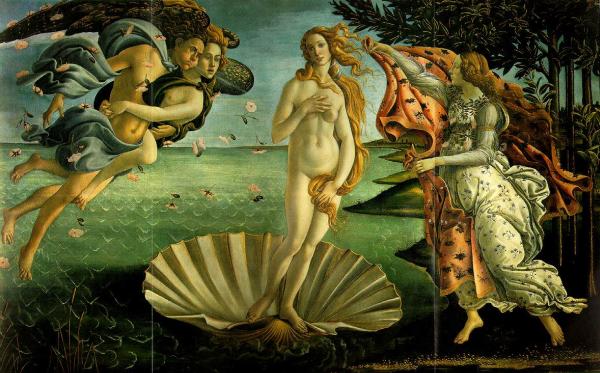Sandro Botticelli Gallery
This secular work was painted onto canvas, which was a less expensive painting surface than the wooden panels used in church and court pictures. A wooden surface would certainly be impractical for a work on such a scale. Canvas is known to have been the preferred material for the painting of non-religious and pagan subjects that were sometimes commissioned to decorate country villas in 15th-century Italy.
Upper-Left: The West Wind
Zephyr and Chloris fly with limbs entwined as a twofold entity: the ruddy Zephyr (his name is Greek for ``the west wind'') is puffing vigorously; while the fair Chloris gently sighs the warm breath that wafts Venus ashore. All around them fall roses--each with a golden heart--which, according to legend, came into being at Venus' birth.
Upper-Right: The Wooded Shore
The trees form part of a flowering orange grove--corresponding to the sacred garden of the Hesperides in Greek myth--and each small white blossom is tipped with gold. Gold is used throughout the painting, accentuating its role as a precious object and echoing the divine status of Venus. Each dark green leaf has a gold spine and outline, and the tree trunks are highlighted with short diagonal lines of gold.
Right: Nymph
The nymph may well be one of the three Horae, or ``The Hours'', Greek goddesses of the seasons, who were attendants to Venus. Both her lavishly decorated dress and the gorgeous robe she holds out to Venus are embroidered with red and white daisies, yellow primroses, and blue cornflowers--all spring flowers appropriate to the theme of birth. She wears a garland of myrtle--the tree of Venus--and a sash of pink roses, as worn by the goddess Flora in Botticelli's Primavera.
Center: The Shell
Botticelli portrays Venus in the very first suggestion of action, with a complex and beautiful series of twists and turns, as she is about to step off her giant gilded scallop shell onto the shore. Venus was conceived when the Titan Cronus castrated his father, the god Uranus--the severed genitals falling into the sea and fertilizing it. Here what we see is actually not Venus' birth out of the waves, but the moment when, having been conveyed by the shell, she lands at Paphos in Cyprus.

viewer |
|
|
Birth of Venus |
| Adoration of the Magi |
| Adoring Angel |
| Dominic |
| Jerome |
| Madonna |
| Zenobius |
| Annunciation |
Biography
Bulletin Board
Renowned Art
(home)
Alessandro di Mariano Filipepi, known as Sandro Botticelli apprenticed with a goldsmith, and with Fra Filippo, an admirable painter of the day. Sandro soon attained to an excellence that no one would have thought possible. While still young he painted many masterpieces and was commissioned to paint the Adoration of the Magi. Sandro created a marvellous work in color, design and composition, that earned him the wonder and admiration of all artists and such a reputation that Pope Sixtus IV entrusted him with the direction of the painting of his chapel in Rome.
all artists, with thumbnails: by birth year | alphabetically
all artists: by birth year | alphabetically
artists born in the 13th 14th 15th 16th 17th 18th 19th 20th century